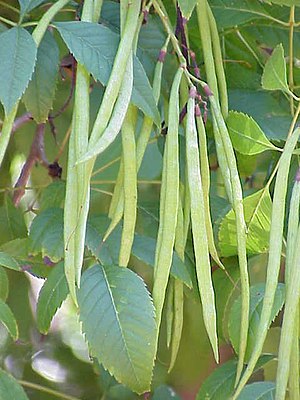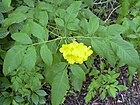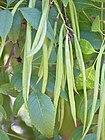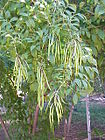Note: This is a project under development. The articles on this wiki are just being initiated and broadly incomplete. You can Help creating new pages.
Tecoma stans
Tecoma stans is a fast-growing shrub or small tree that can reach a height of 5 - 8 metres. The plant is often grown as an ornamental by virtue of its many yellow trumpet-shaped, scented flowers, it is also sometimes cultivated for its medicinal virtues, as a hedge and to provide shade.
Contents
[hide]- 1 Uses
- 2 Parts Used
- 3 Chemical Composition
- 4 Common names
- 5 Properties
- 6 Habit
- 7 Identification
- 8 List of Ayurvedic medicine in which the herb is used
- 9 Where to get the saplings
- 10 Mode of Propagation
- 11 Season to grow
- 12 Soil type required
- 13 Ecosystem/Climate
- 14 How to plant/cultivate
- 15 Commonly seen growing in areas
- 16 Photo Gallery
- 17 References
- 18 External Links
Uses
Diabetes, Stomach pains, Syphilis, Intestinal worms.[1]
Parts Used
Chemical Composition
Chemical constituents of this botanical species are well known; numerous monoterpenic alkaloids have been identified.[2]
Common names
| Language | Common name |
|---|---|
| Kannada | |
| Hindi | Piliya |
| Malayalam | |
| Tamil | Sonnapatti |
| Telugu | Pachagotla |
| Marathi | |
| Gujarathi | |
| Punjabi | |
| Kashmiri | |
| Sanskrit | |
| English | Yellow bells, Yellow trumpet |
Properties
Reference: Dravya - Substance, Rasa - Taste, Guna - Qualities, Veerya - Potency, Vipaka - Post-digesion effect, Karma - Pharmacological activity, Prabhava - Therepeutics.
Dravya
Rasa
Guna
Veerya
Vipaka
Karma
Prabhava
Habit
Identification
Leaf
| Kind | Shape | Feature |
|---|---|---|
| Arranged in pairs | Borne on slender stalks |
Flower
| Type | Size | Color and composition | Stamen | More information |
|---|---|---|---|---|
| Trumpet | 2" long | Bright yellow in colour | Flowering season is September-February | {{{5}}} |
Fruit
| Type | Size | Mass | Appearance | Seeds | More information |
|---|---|---|---|---|---|
| Bean type capsule | 8" long | That ripens to a chocolate brown colour, Fruiting season is September-February |
Other features
List of Ayurvedic medicine in which the herb is used
Where to get the saplings
Mode of Propagation
Seeds, Regeneration by cuttings.
Season to grow
It will grow in clusters from April till November.
Soil type required
It prefers moderately moist soil.[5]
Ecosystem/Climate
This plant is autocompatible and requires external pollination.[6]
How to plant/cultivate
A plant of drier areas in the tropics and subtropics, it can be found at elevations from sea level to around 2,000 metres.[7]
Commonly seen growing in areas
Photo Gallery
References
- Jump up ↑ Indian Medicinal Plants by C.P.Khare
- Jump up ↑ Chemical constituents
- Jump up ↑ Common names
- Jump up ↑ Kappatagudda - A Repertoire of Medicianal Plants of Gadag by Yashpal Kshirasagar and Sonal Vrishni, Page No. 362
- Jump up ↑ Soil type required
- Jump up ↑ Climate required
- Jump up ↑ Cultivation
External Links
- Ayurvedic Herbs known to be helpful to treat Diabetes
- Ayurvedic Herbs known to be helpful to treat Stomach pains
- Ayurvedic Herbs known to be helpful to treat Syphilis
- Ayurvedic Herbs known to be helpful to treat Intestinal worms
- Herbs with Leaves used in medicine
- Herbs with Flowers used in medicine
- Herbs with common name in Hindi
- Herbs with common name in Tamil
- Herbs with common name in Telugu
- Herbs with common name in English
- Habit - Evergreen shrub
- Index of Plants which can be propagated by Seeds
- Index of Plants which can be propagated by Regeneration by cuttings
- Herbs that are commonly seen in the region of Disturbed areas
- Herbs that are commonly seen in the region of Roadsides
- Herbs







